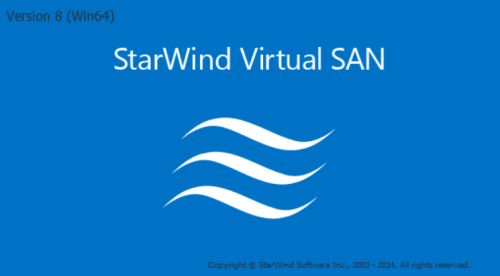One important thing you need for your virtual environment is storage. If you have a single ESXi host then using local storage is just fine but if you have multiple hosts and want to use features such as vMotion, High Availability (HA) , and DRS you need shared storage. In my quest to find a storage solution I started out using my Synology DS411slim. It works fantastically but I am very limited with speed and drive size due to the 2.5″ drive limitation. With the cost very high for a new Synology unit it left me seeking an alternative solution, that is where StarWind Virtual SAN steps in. StarWind Virtual SAN presents a servers local storage as a iSCSI LUN and even performs VMware VAAI functions.
There is a free edition StarWind offers that is perfect for home labs, test and dev environments. You can download and receive your license key here: http://www.starwindsoftware.com/starwind-virtual-san-free
Prerequisites:
At a minimum all you need is some local storage and a network connection as you will be presenting it out as iSCSI. Luckily I have a Dell PowerEdge R520 that will become my virtual SAN server. For better performance, you should have storage running on a RAID (5,10, etc) and multiple network connection that will be dedicated for iSCSI traffic. I have eight 300GB 10k SAS drives using RAID 5, I carved 300GB for my boot drive which left 1.6 TB for my D:\ drive.
Installation:
Installation and setup of Starwind Virtual SAN is super easy. You can have it installed and presenting storage in roughly 5 minutes! The install process is pretty much straight forward but is documented below:
Agree and click Next:
Read through the information, click Next:
Pick your installation directory, click Next:
Recommend doing a full install (only 108.4 MB), click Next:
Pick if you want a desktop icon, click Next:
Review and click Install:
Storage Management Initiative – Specification (SMI-S) is a management standard for SANs. You can read more about it here. Go ahead and click Yes:
Only thing you should do is set a password. Type a password of your choosing, click Ok:
Leave the check in the box to launch the Management Console, click Finish:
Installation is complete!
Configuration and Setup:
It is asking you what drive and location you want to store the virtual SAN hard drive files. In my case it’s the D:\ drive. Change yours if applicable:
Welcome to the StarWind Management Console. We only have two more things to do before we have a operational virtual SAN.
If you have multiple network connections you can dedicate some of them only for iSCSI traffic.
In my case I have four connection and will dedicate two NICs (well, once I plug in my second cable) :). Each of my two ESXi hosts will have their own dedicated NIC for storage traffic:
Back on the Management Console, click on the Configuration tab, then Network. If you are dedicating iSCSI traffic go ahead and remove the IP address of the server. Then only your iSCSI NICs will be listed. If you aren’t going this approach then ignore this step.
Now, let’s create the disk that will be the storage of your virtual SAN. Click on Add Device, you can change the name if you want or leave the default Storage1, type in how much space to make the disk and click Next:
Now click Create:
Finished! Click Close:
We now have virtual SAN storage!!
Configuring ESXi Host for iSCSI:
Now we can configure the host to find our virtual disk. Go to your host, Configuration tab, then Storage Adapters. If you have a iSCSI card you can use it or you can add a software iSCSI Adapter. Right click your iSCSI adapter and click Properties:
Click on Dynamic Discovery then click Add:
Enter the IP address of your StarWind Virtual SAN server then click Ok:
You will see the entry, now click Close:
Click on Yes for it to perform a scan:
You should now see the Starwind disk appear!!



























